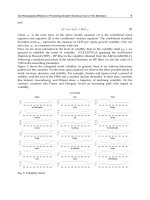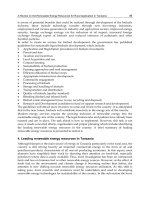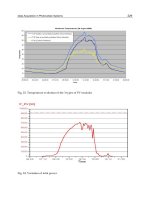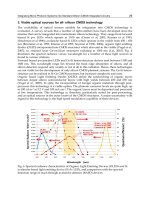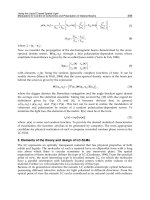Renewable Energy Trends and Applications Part 2 docx
Bạn đang xem bản rút gọn của tài liệu. Xem và tải ngay bản đầy đủ của tài liệu tại đây (486.06 KB, 20 trang )
Are Renewables Effective in Promoting Growth? Evidence from 21 EU Members
9
and
222
11ttt
, (2)
where
t
is the error term. In the above model, equation (1) is the conditional mean
equation and equation (2) is the conditional variance equation. The conditional standard
deviation term,
t
, represents the measure of GDP per capita growth volatility. One can
also view
t
as a measure of economy wide risk.
Since we are more interested in the level of volatility than in the volatility itself (
t
), we
proceed to establish the trend of volatility (VOLGDPPCct) applying the well-known
Hodrick & Prescott (1997) – HP filter to the volatility obtained from the AR(1)-GARCH(1,1).
Following a standard procedure of the related literature on HP filter, we use the value of λ
=100 as the smoothing parameter.
Figure 3 shows the computed trend volatility. In general, there is no uniform behaviour
pattern for the countries. For the time span analysed we observe the three possible kinds of
trend: increase, decrease, and stability. For example, Austria and Spain reveal a period of
stability until the end of the 1990s and a marked decline thereafter. In their turn, countries
like Ireland, Luxembourg, and Poland show a trajectory of declining volatility. On the
contrary, countries like France and Hungary reveal an increasing path with regard to
volatility.
Fig. 3. Volatility trend
Trend Volatilit
y
Belgium
1990 1992 1994 1996 1998 2000 2002 2004 2006
1.74
1.84
the Czech Republic
1990 1992 1994 1996 1998 2000 2002 2004 2006
2.1
2.6
Denmark
1990 1992 1994 1996 1998 2000 2002 2004 2006
1.95
2.15
2.35
Germany
1990 1992 1994 1996 1998 2000 2002 2004 2006
1.650
1.775
Estonia
1990 1992 1994 1996 1998 2000 2002 2004 2006
5.5
7.0
8.5
Ireland
1990 1992 1994 1996 1998 2000 2002 2004 2006
3.4
3.8
4.2
Greece
1990 1992 1994 1996 1998 2000 2002 2004 2006
2.0
2.3
2.6
Spain
1990 1992 1994 1996 1998 2000 2002 2004 2006
1.45
1.60
1.75
France
1990 1992 1994 1996 1998 2000 2002 2004 2006
1.30
1.45
1.60
Italy
1990 1992 1994 1996 1998 2000 2002 2004 2006
1.2
1.6
2.0
Luxembourg
1990 1992 1994 1996 1998 2000 2002 2004 2006
2.15
2.35
Hungary
1990 1992 1994 1996 1998 2000 2002 2004 2006
2.7
3.2
the Netherlands
1990 1992 1994 1996 1998 2000 2002 2004 2006
1.50
1.75
Austria
1990 1992 1994 1996 1998 2000 2002 2004 2006
1.70
1.90
Poland
1990 1992 1994 1996 1998 2000 2002 2004 2006
2.06
2.14
2.22
Portugal
199019921994199619982000200220042006
1.6
1.9
2.2
Slovenia
1990 1992 1994 1996 1998 2000 2002 2004 2006
2.00
2.20
2.40
the Slovak Republic
1990 1992 1994 1996 1998 2000 2002 2004 2006
4
7
10
Finland
199019921994199619982000200220042006
2.0
2.8
Sweden
199019921994199619982000200220042006
1.8
2.2
United Kingdom
199019921994199619982000200220042006
1.4
2.0
Renewable Energy – Trends and Applications
10
- Logarithm of the contribution of renewables to total primary energy supply, lagged one period
(LCRESct-1). As discussed earlier, it is well known that economic growth is heavily
dependent on energy use. Therefore, the contribution of each source towards economic
growth should be assessed. Although renewables have yet to play a leading role in the
total picture of energy sources in most countries, the relationship between renewables
and economic growth must be evaluated. In reality, we are witnessing a growth rate of
this source, largely as a result of public policies. On the one hand, these market opening
policies or market driven policies take time to produce the desired effects and, on the
other hand, the present productive structures are mostly suitable for the use of
traditional sources. Thus, we control for the logarithm of the contribution of renewables
to total primary energy supply, lagged one period. The effect of LCRESct-1 can evolve
in two directions. On the one hand, greater use of renewables may encourage the
development of this entire industry, creating jobs and wealth locally. In this scenario,
we will have a positive effect. On the other hand, greater use of renewables may involve
the abandonment of fossil-based productive capacity and, therefore, we can observe a
negative effect of renewables on economic growth. If the cost of the market-opening
policies is excessively placed on the economy, then this negative effect can also be
enlarged. If the second effect overcomes, then a negative signal is achieved.
- Contribution of coal, oil, gas, and nuclear to electricity generation (SCOALEGct, SOILEGct,
SGASEGct, and SNUCLEGct). The conventional energy sources, including both fossil
fuels and nuclear energy, are the dominant sources of energy and, as such, we control
for the effect of all these sources on economic growth. Since the production structures in
Europe are geared mainly towards the use of oil, we anticipate a clear positive effect for
this source on economic growth. The same is expected to happen with nuclear power.
With regard to coal and natural gas, given that the former source is highly inefficient
and the latter is relatively recent, the expected effect may not be obvious a priori.
3.3 Method
This chapter makes use of panel data techniques to assess the nature of the effects of the
several energy sources, and other drivers, on economic growth. Complex compositions of
errors could be present in panel data analysis. The general model to estimate is:
1
1
,
k
ct ct k kct c t ct
k
LGDP LCRES X d d
(3)
where LCRES
ct−1
is the share of renewables of country c in period t−1. The dummy variables
c
d
and
t
d
refer to country and time, respectively. In the error term
,1ct c c t ct
,
ct
is
serially uncorrelated, but correlated over countries.
To deal with the complexity of the errors, good econometric practices suggest performing the
analysis by first making a visual inspection of the nature of the data, followed by a battery of
tests to detect the possible presence of heteroskedasticity, panel autocorrelation, and
contemporaneous correlation. We use the Modified Wald test (Baum, 2001) in the residuals of
a fixed effect regression, to appraise the existence of groupwise heteroskedasticity. The
Modified Wald test has
2
distribution and tests the null of:
22
c
, for 1, ,cN . The
Wooldridge test assesses the presence of serial correlation. It is normally distributed
N(0,1) and
it tests the null of no serial correlation. We use the parametric testing procedure proposed by
Are Renewables Effective in Promoting Growth? Evidence from 21 EU Members
11
Pesaran (2004), the non-parametric test from Friedman (1937) and the semi-parametric test
proposed by Frees (1995 and 2004), either for fixed effects or random effects, to test the
countries’ independence. Pesaran’s test is a parametric testing procedure and follows a
standard normal distribution; Frees’ test uses Frees’ Q-distribution; Friedman’s test is a non-
parametric test based on Spearman’s rank correlation coefficient. All these tests - Pesaran,
Frees and Friedman - test the null of cross-section independence.
Within a panel data analysis, the presence of such phenomena discourages the use of the
common Fixed Effects (FE) and Random Effects (RE) estimators, due to the inefficiency in
coefficient estimation and to biasedness in the estimation of standard errors they could
cause. In this case, the appropriate estimators to be used are the Feasible Generalised Least
Squares (FGLS) and the Panel Corrected Standard Errors (PCSE). In our sample, the number
of cross sections (21) is larger than the number of time periods (18) and, therefore, the best
suited estimator to deal with the presence of panel-level heteroskedasticity and
contemporaneous correlation is the PCSE (Reed & YE, 2009).
The PCSE estimator allows the use of first-order autoregressive models for
ct
over time in
(3), it allows
ct
to be correlated over the countries, and allows
ct
to be heteroskedastic
(Cameron and Triverdi, 2009). We begin by estimating a pooled OLS model (model I) and
then we work on a panel data structure by applying the PCSE estimator. We will estimate
the model presupposing the various assumptions about variances across panels and serial
correlations, with the aim of checking the robustness of the results. The assumptions made
throughout the models are as follows: model II - correlation over countries and no
autocorrelation; model III – country-level heteroskedastic errors and common first-order
autoregressive error (AR1); model IV - correlation over countries and autocorrelation AR(1);
and model V - correlation over countries and autocorrelation country-specific AR(1).
3.4 Data
The data used in this chapter come from several sources. Table 1 summarises the variables,
their sources and their descriptive statistics. The time span is 1990-2007, and we collect data
for 21 EU Members, those for which there are available data for all the variables.
Variable Definition Source Obs Mean SD Min Max
Dependent
LGDP
ct
Logarithm of
real Gross
Domestic
Product
(billion dollars,
2005)
World Bank
World
Development
Indicators, and
International
Financial IMF
Statistics
378 5.3867 1.4966 1.9095 7.9921
Independent
ENERGPC
ct
Per capita
energy
(kgoe/cap)
EU Energy in
Figures 2010
DG TREN
378 4062.822 1590.981 1753.7 10132.98
Renewable Energy – Trends and Applications
12
Variable Definition Source Obs Mean SD Min Max
VOLGDPPC
ct
Per capita GDP
volatility
Own
calculation.
Raw data
from World
Bank World
Development
Indicators, and
International
Financial
Statistics of the
IMF
378 2.5407 1.2422 1.0622 8.7522
LCRES
ct-1
Logarithm of
the factor of
contribution of
renewables to
total primary
energy supply,
lagged one
period
OECD
Factbook 2010
376 1.5965 1.0126 -1.6094 3.4404
IMPTDP
ct
Import
dependency of
energy (%)
EU Energy in
Figures 2010
DG TREN
378 52.2925 29.6911 -50.83 99.8
SCOALEG
ct
Contribution of
coal to
electricity
generation
Ratio
electricity
generation to
coal (TWh) /
total elect.
generation
(TWh). EU
Energy in
Figures 2010
DG TREN
378 0.3614 0.2753 0 0.97
SOILEG
ct
Contribution of
oil to electricit
y
generation
Ratio
electricity
generation to
oil / total elect.
Generation. EU
Energy in
Figures 2010
DG TREN
378 0.0698 0.0983 0 0.51
Are Renewables Effective in Promoting Growth? Evidence from 21 EU Members
13
Variable Definition Source Obs Mean SD Min Max
SGASEG
ct
Contribution of
gas to
electricity
generation
Ratio
electricity
generation to
gas / total
elect.
Generation. EU
Energy in
Figures 2010
DG TREN
378 0.1694 0.1747 0 0.76
SNUCLEG
ct
Contribution of
nuclear to
electricity
generation
Ratio
electricity
generation to
nuclear / total
elect.
Generation. EU
Energy in
Figures 2010
DG TREN
378 0.2126 0.2306 0 0.78
Table 1. Data: definition, sources and descriptive statistics
First following a visual inspection of the data, we analyse the correlation coefficients,
which are disclosed in the correlation matrix (table 2). In general, the correlation
coefficients did not arouse any particular concern about the existence of collinearity
among explanatory variables, although the correlation of VOLGDPPC with LGDP may be
a possible exception.
Variables
LGDP
ct
ENERGPC
ct
VOLGDPPC
ct
LCRES
ct-1
IMPTDP
ct
SCOALEG
ct
LGDP
ct
1
ENERGPC
ct
-0.1478 1
VOLGDPPC
ct
-0.6610 -0.0209 1
LCRES
ct-1
-0.0332 -0.0919 -0.1471 1
IMPTDP
ct
-0.1230 0.1585 0.0574 0.0838 1
SCOALEG
ct
-0.2211 -0.4187 0.1621 -0.1871 -0.4832 1
SOILEG
ct
0.1553 -0.4307 -0.1612 0.0342 0.3339 -0.0579
SGASEG
ct
0.1260 0.3487 -0.1024 -0.3672 0.1555 -0.3434
SNUCLEG
ct
0.1895 0.1240 0.0889 0.0640 0.0151 -0.4177
SOILEG
ct
SGASEG
ct
SNUCLEG
ct
SOILEG
ct
1
SGASEG
ct
0.0495 1
SNUCLEG
ct
-0.3642 -0.3310 1
Table 2. Correlation matrix
Renewable Energy – Trends and Applications
14
In order to dispel any doubt we proceed as follows: i) we estimate the models excluding the
variable volatility, concluding that there is no change in the coefficients' signals; ii) we
compute the Variance Inflation Factor (VIF) test for multicollinearity (see table 3). The mean
VIF is only 2.35 and the largest individual VIF is 4.21. From all this we conclude that
collinearity is not a concern.
Variables
VIF 1/VIF
SCOALEG
ct
4.21 0.237790
SNUCLEG
ct
3.12 0.321027
SGASEG
ct
2.79 0.358631
SOILEG
ct
2.25 0.444951
ENERGPC
ct
1.98 0.504358
LCRES
ct-1
1.69 0.592946
IMPTDP
ct
1.65 0.604563
VOLGDPPC
ct
1.15 0.867271
Mean VIF
2.35
Table 3. Variance Inflation Factor
Once the first inspection of the data had been made, we proceeded by testing the intrinsic
characteristics of the data, namely by assessing the presence of the phenomena previously
reported, i.e., heteroskedasticity, panel autocorrelation, and contemporaneous correlation.
Table 4 reveals the specification tests we computed.
Pooled Random Effects Fixed Effects
Modified Wald test (χ
2
)
4885.68***
Wooldridge test F(N(0,1))
371.271***
Pesaran’s test
8.592*** 8.069***
Frees’ test
5.525*** 5.749***
Friedman’s test
62.200*** 59.514***
Note: *** denotes 1% significance level.
Table 4. Specification tests
From table 2, the null hypothesis of no first-order autocorrelation is rejected, as suggested
by the Wooldridge test. From the Modified Wald statistic, we observe that the errors exhibit
groupwise heteroskedasticity. As far as the contemporaneous correlation is concerned, all
the tests are unanimous in their conclusions. They support the rejection of the null of cross-
sectional independence, and thus the residuals do not appear to be spatially independent.
The use of the PCSE is therefore sustained.
4. Results
After analysing the properties of the data, and since the pre-tests supported our choice for
the estimations procedures, we proceeded to the presentation of estimation results, as well
as their interpretation. Table 5 discloses the results and diagnostic tests.
Are Renewables Effective in Promoting Growth? Evidence from 21 EU Members
15
De
p
endent variable LGDP
c
t
Independent
variables
OLS
Model I
PCSE
M
odel II
M
odel III
M
odel I
V
M
odel
V
ENERGPC
ct
-0.0002***
(
0.0000
)
-0.0002***
(
0.0000
)
-0.0001***
(
0.0000
)
-0.0001***
(
0.0000
)
-0.0002***
(
0.0000
)
VOLGDPPC
ct
-0.7972***
(
0.0412
)
-0.7972***
(
0.0436
)
-0.4913***
(
0.0571
)
-0.4913***
(
0.0676
)
-0.4456***
(
0.0630
)
LCRES
ct-1
-0.0256***
(
0.0676
)
-0.2563***
(
0.0316
)
-0.0916**
(
0.0366
)
-0.0916***
(
0.0303
)
-0.0920***
(
0.0297
)
IMPTDP
ct
-0.0086***
(
0.0021
)
-0.0086***
(
0.0011
)
-0.0028*
(
0.0015
)
-0.0028**
(
0.0013
)
-0.0059***
(
0.0015
)
SCOALEG
ct
-0.6137*
(
0.3599
)
-0.6137***
(
0.2032
)
-0.2811
(
0.2162
)
-0.2811*
(
0.1678
)
-0.3495**
(
0.1702
)
SOILEG
ct
2.4772***
(0.7353)
2.4772***
(0.2998)
1.0848***
(0.3197)
1.0848***
(0.2359)
1.1918***
(0.2558)
SGASEG
ct
1.0171**
(
0.5107
)
1.0171***
(
0.3332
)
0.4774*
(
0.2452
)
0.4774**
(
0.1893
)
0.6929***
(
0.2012
)
SNUCLEG
ct
2.2215***
(
0.3674
)
2.2215***
(
0.1549
)
1.3139***
(
0.2601
)
1.3139***
(
0.1988
)
1.4048***
(
0.1855
)
CONS
8.3756***
(
0.4916
)
8.3756***
(
0.2644
)
6.9737***
(
0.2506
)
6.9737***
(
0.2556
)
6.9991***
(
0.2505
)
Observations
376 376 376 376 376
R
2
/
Pseudo R
2
0.6465 0.6465 0.8555 0.8555 0.8961
F (N(0,1))
25.61***
Wald (
χ
2
)
96981.67*** 170.97*** 656.20*** 722.13***
Exclusion tests
f
or VOLGDPP
C
c
t
and LCRES
c
t
-1
JST
188.35*** 378.61*** 76.59*** 53.39*** 52.11***
LRT
-1.0535***
(0.0834)
-1.0535***
(0.0559)
-0.5829***
(0.0709)
-0.5829***
(0.0825)
-0.5346***
(0.0759)
Exclusion tests for SCOALEG
ct
, SOILEG
ct
, SGASEG
ct
, and SNUCLEG
ct
JST
32.11*** 673.23*** 51.07*** 58.38*** 70.24***
LRT
5.1021***
(1.5008)
5.1021***
(0.7610)
2.5949***
(0.6658)
2.5949***
(0.5056)
2.9401***
(0.5212)
Notes: OLS - Ordinary Least Squares. PCSE – Panel Corrected Standard Errors. The F-test is normally
distributed N(0,1) and tests the null hypothesis of non-significance as a whole of the estimated parameters.
The Wald test has
2
distribution. It tests the null hypothesis of non-significance of all coefficients of
explanatory variables; JST - Joint Significance Test. JST is a Wald (
2
) test with the null hypothesis of
:0
Ok
H
, with
and
k
the coefficients of LCRES
ct-1
and the other explanatory variables,
respectively. LRT - Linear Restriction Test has the null hypothesis of
:0
Ok
H
. All estimates were
controlled to include the time effects, although not reported for simplicity. Standard errors are reported in
brackets. ***, **, *, denote significance at 1, 5 and 10% significance levels, respectively.
Table 5. Results
Renewable Energy – Trends and Applications
16
Globally, results reveal great consistency and they are not dependent on the assumptions we
made about variances across panels and serial correlations. There are no signal changes and,
in general, the explanatory variables prove to be consistently statistically significant
throughout the models.
The impact of both energy consumption per capita and import dependency on energy on
economic growth is negative and statistically significant. The effect of the volatility on
economic growth is negative and statistically highly significant. This result supports the
assumption that higher volatility contributes to reducing economic growth. Results also
provide strong evidence that the impact of energy on economic growth is dissimilar,
varying according to the source of energy. While oil and nuclear reveal a positive and
statistically highly significant effect on economic growth, it seems that renewables are
hampering economic growth. This negative and statistically significant relationship is
consistent throughout the several models. The effect of the fossil source natural gas on
economic growth is positive and statistically significant, albeit at a lower level of
significance (5% and 10%). This probably comes from the fact that this source is playing a
recent role as a transition source from heavily polluting sources towards cleaner ones. The
effect of coal on economic growth is not always statistically significant and, when
significant, it is negative.
We deepen the adequacy of use of the variables LCRES
ct-1
and VOLGDPPC
ct
since their use
is not widespread in the literature. Additionally, we test the simultaneous use of
SCOALEG
ct
, SOILEG
ct
, SGASEG
ct
, and SNUCLEGct. For that purpose, we provide two
exclusion tests: i) Joint Significant Test - JST; and ii) Linear Restriction Test -LRT. The
variables LCRES
ct-1
and VOLGDPPC
ct
, together, must be retained as explanatory variables.
Nevertheless, the sum of the estimated coefficients could not be statistically significant in
explaining economic growth. From the LRT we reject the null hypothesis and then the sum
of their coefficients is different from zero. The same conclusion is reached when we test the
adequacy of the simultaneous control for the variables SCOALEG
ct
, SOILEG
ct
, SGASEG
ct
,
and SNUCLEGct. These variables must belong to the models. Together with the
appropriateness of the use of PCSE, these tests corroborate the relevance of the explanatory
variables, other than energy consumption per capita and import dependency on energy,
since these are well described in the literature.
5. Energy consumption, dependency and volatility
To conclude that the higher the level of energy dependency, the lower the economic growth,
is more intuitive than checking that the consumption of energy has the same negative
impact on economic growth. However, looking carefully at these two relationships, both
effects are understandable and expected. Regarding energy consumption, it is confirmed
that the negative effect outweighs the positive one. As discussed above, this may be the
result of two phenomena. On the one hand, this suggests that the additional consumption of
energy stems from activities other than production, such as leisure activities. On the other
hand, this additional consumption could be causing an overload in the external deficit of
energy, for most EU Members.
The hypothesis that the dependency on energy imports is limiting economic growth is
confirmed. Additional energy dependency means that the country becomes more subject to
external constraints and to the rules, terms and prices set by other countries and external
markets. Meanwhile, greater volume of energy imports is matched by financial outflows.
Are Renewables Effective in Promoting Growth? Evidence from 21 EU Members
17
With respect to prices and diversification of primary energy sources, if larger energy
dependency confers an advantage to the country, then it is likely that this dependency could
have positive effects on economic growth. The reality is somewhat different, however. On
the one hand, it appears that, in general, countries are price-takers in the international
energy markets and, as such, they cannot influence prices. On the other hand, diversification
of energy sources can lead to the need for diversified investments, which are expensive and
are not sized to take advantage of economies of scale.
One of the common-sense ways to offset this negative effect will be the replacement of
imports. To do so, countries can locally produce some of their energy needs, through the use
of indigenous renewable resources. However, till now, the use of these resources to convert
into electricity does not seem to produce the desired effects. On the contrary, it seems to
limit the economic growth capacity of countries, in contrast to what happens with fossil
energy sources.
Regarding the negative effect of volatility on economic growth, this result is in line with the
hypothesis that the characteristic of irreversibility that is inherent in physical capital makes
investment particularly susceptible to diverse kinds of risk (Bernanke, 1983; and Pindyck,
1991). Indeed, growth volatility produces risks regarding potential demand that hamper
investment, generating a negative relationship between economic growth and its volatility.
Other possible explanations are based on the learning-by-doing process, which contributes
to human capital accumulation and improved productivity, which was assumed to be
negatively influenced by volatility (e.g. Martin and Rogers, 2000).
6. Renewables vs traditional sources
By the end of the 21
st
century, it is accepted that we will no longer be using crude oil as a
primary source of energy, as a consequence of its depletion. However, the coal situation is
different. The reserves are large and will remain widely available for a long time, perhaps
even for a century. Unfortunately, this source is both highly polluting and not so efficient.
Similarly, natural gas will be available in larger quantities than the crude oil reserves, even
considering that some of its reserves remain unknown. It will remain available as a primary
source of energy even until the turn of the century. The conversion of natural resources into
energy, mainly into electricity, is a matter of crucial importance within this context of
changing the global energy paradigm.
With regard to the impact of different energy sources on economic growth, there seems to be
a dichotomy between the effects that are caused by the use of renewable and traditional
sources, which include fossil and nuclear sources. Both oil and natural gas stimulate
economic growth in the period and countries considered, in line with what has been pointed
out by the literature (e.g. Yoo, 2006) and with the growth hypothesis. The effect of coal on
economic growth is statistically weaker than the other fossil fuels and, when statistically
significant, this source of energy constrains economic growth.
Among the fossil fuels, oil is the source that has mostly contributed to economic growth.
Given that the productive structures of the industrialised nations, such as those under
review here, which are highly dependent on the intensive use of internal combustion
engines, this effect was expected. Natural gas also has a positive effect on economic growth,
although this source of energy has been particularly significant in recent years. This is due
not only to the advances concerning the discovery of new reserves, but also to the
considerable increase in the network of natural gas pipelines. At the same time, the
Renewable Energy – Trends and Applications
18
combined cycle plants, which use mainly natural gas as fuel, have been used to guarantee
electricity supply within the RE development strategy. This fact has contributed to
stimulating the development of this energy source. It is a cleaner source, and is considered
the transition source from fossil fuels to renewable sources.
Although the fact that RE limit economic growth is an unexpected result, it is one that
deserves deep reflection in this chapter. Policy makers should be made aware of the global
impacts of policies promoting the use of renewables. At first glance, the development of
renewables should have everything to make it a resoundingly successful strategy. With this
strategy, it would be possible to fight global warming, reduce energy dependency (not only
economic but also geo-political), create sustainable jobs and develop a whole renewables
cluster. What these results suggest is that the effects of renewables are more normative than
real, i.e., the results are far from what they should be. Indeed, the development of
renewables has been supported in public policies that substantially burden the final price of
electricity available for final consumption to economic agents. At the same time, the
productive structures of the countries are still heavily dependent on fossil-based
technologies, such as internal combustion engines. Their conversion towards other
technologies is a slow and expensive path.
7. The role that renewables play and what we want them to play
It is worth discussing, in more detail, the observed effect of renewables on economic growth.
The main motivations for the use of RE are diverse, as indicated above. One of the most
widely claimed is that of environmental concerns. Renewables allow traditional production
technologies to be replaced with other cleaner technologies, with lower emissions of
greenhouse gases, in line with what is suggested by De Fillipi & Scarano (2010). The
question that many countries, such as the United States of America, have raised is that this
substitution severely limits the capacity for growth. This is the ultimate cause for the non-
ratification of important international treaties like the Kyoto Protocol.
Moreover, it is far from unequivocally proven that more intensive use of renewables
contributes decisively to the reduction of CO2 emissions, in line with what was pointed out,
for example, by Apergis et al. (2010). In this chapter we tested the inclusion of CO2
emissions as an explanatory variable, but it proved not to be statistically significant.
Renewable sources should be placed within the mix of energy sources, requiring the
simultaneous use of other sources, mostly fossil. The intermittency of renewables cannot be
compensated by the use of nuclear energy. The offset of the lack of production from
renewables implies the ability to frequently turn these other sources of support on and off,
which is obviously not possible when it comes to nuclear energy. The counterbalance has to
be made by fossil fuels, mainly natural gas and coal. The latter is a cheaper source of energy
but at the same time is also highly polluting.
The growing use of RE has been heavily dependent on policy guidance. Most EU Members,
either voluntarily or compulsorily, have established several mechanisms to support these
alternative sources of energy. One of the most commonly used policies is the feed-in tariff,
which consists of setting a special price that rewards energy from clean sources. This policy
and all other public policies lead to government expenses. These costs are passed on by the
regulators to the final consumer, both residential and firm consumers. When they are not
passed on by regulators in the regulated market, then in the liberalised market, the
producers transfer to consumers the extra costs they have when producing energy from
Are Renewables Effective in Promoting Growth? Evidence from 21 EU Members
19
renewable sources. This strategy of promoting RE can thus burden the economy with
electricity costs that are too high and therefore hinder economic growth.
It is already clear that the overall strategy for electrification of the economy requires large
volumes of financial resources, which may be diverted from other alternative projects.
However, the massive investment in renewables may promote divestments, not only in the
technological upgrades of other conventional sources of energy, but also in other industrial
projects. In order to be able to achieve compliance with the requirements of market entry,
and to keep innovating mainly through R&D, players in renewables are obliged to issue
debt. Given that the available financial resources are scarce, this debt from renewables may
be preventing players in other industries, with even greater multiplier effects on economic
growth, from achieving fair interest rates which do not compromise the appropriate return.
In this regard, it is worth highlighting that another factor which may help explain the
negative effect of renewables on economic growth is that the investment should be paid
during its usable life, as good practices suggest. The reality shows that this normally does
not happen. Consumers have to start to bear the cost of a wind farm or solar park almost
immediately. More serious still is that the Government requires the payment for a licence
allocation of power generation in advance. After that, the Government guarantees prices for
the purchase of the electricity generated. Finally, the winners of the bids will capture the
regulators to immediately recover these costs of entry. Overall, this has little to do with the
nature of renewable technology. Instead, it is more a launch of a tax resulting from
renewables diverted to electricity costs and, ultimately, on consumers and on the economy
as a whole.
No less important within this discussion of the effect of renewables on economic growth is
the effect brought about by renewables on the technology and production capacity already
installed. In fact, greater use of renewables implies the dismantling or simply the creation of
excess capacity based on conventional sources. Note that, in the past, these sources
represented a major cause of the degree of development, industrialisation and prosperity of
the countries. They grew mainly supported on technologies based on fossil sources of
energy. The increased use of renewables can thus be causing two outcomes. On the one
hand, renewables may diminish the positive effect of conventional sources on economic
growth. On the other hand, renewables discourage technological upgrades of conventional
sources. Nonetheless, these sources can still evolve, both as regards the level of energy
efficiency (thus reducing dependency), and as regards greenhouse gas emissions.
It should be noted that the results presented in this chapter were obtained by studying
evidence from 1990 to 2007. They do not allow us to unequivocally conclude that RE will not
stimulate economic growth in the near future. Indeed, the studies using official statistics on
energy produced from renewable sources inevitably suffer from a problem that could lead
to some kind of bias in the results. The official statistics on the use of RE normally do not
reveal the true contribution of these sources both to our lives and to the economy as a
whole. There is a plethora of examples that illustrate this failure in the statistics. When the
sun comes through the windows of our homes or businesses, effectively heating them, there
are significant energy savings by avoiding the use of traditional energy sources. The
statistics also do not capture the effect when the sun heats the water that we use both for
bathing and industrial activities. The sunlight that enables the achievement of sporting
events, entertainment and various economic activities without resorting to light bulbs is a
valuable contribution of this renewable source, but it is also absent from official statistics.
Renewable Energy – Trends and Applications
20
Solar radiation allows the growth of plants, both for biomass and food, which in turn creates
energy. Finally, it should not be forgotten that solar radiation allows the chemical process
for the formation of fossil fuels. The natural resource water does not only provide the water
supply for dams for electricity generation, with the particularity of this feature in allowing
storage. In short, by not considering all these effects from renewables, the results that come
from the use of official sources of statistics may not give the full picture of the effect of
renewables. All the energy that results from natural and renewable sources is generally not
included in the statistics, but it is an invaluable contribution to reducing the use of other
sources, mainly polluting fossil sources.
In general, if taken together, renewables are likely to contribute positively to the process of
economic growth. However, regarding the use of natural sources for electricity generation
through direct human intervention, such as wind and photovoltaic facilities, it seems that
the desired results are still a long way off. In fact, this may distort the conclusions about the
contribution of renewables to economic growth. The immediate challenge will therefore be
to strengthen the use of these renewable sources, in their natural state. In other words, both
the organisation of society and the economy should be more consistent with the
maximisation of benefits from these natural sources. Just two simple examples. First, more
energy-efficient houses must be built. They should maximise the benefits of solar power for
heating, while wind, rain and vegetation should contribute to cooling them. Second, both
sports and musical shows should be performed during periods when natural light
eliminates the need for artificial lighting, which consumes a great deal of electricity.
Overall, a country’s decision to intensify the use of the RE mix is eminently political, rather
than economic. In this process, there are two strongly related factors that will influence the
role of renewables in the economy. The first concerns the evolution of technology converting
energy emitted by renewable sources into usable energy, such as electricity. The second
factor is of a political nature. The consequences for renewables will be rooted in this political
process. We believe it is essential that the regulatory authorities do not excessively and
quickly pass costs of RE production to the economy. Instead, they should commit players
operating in this industry to assuming a significant part of the risks inherent in these
energies.
8. Conclusion
This chapter is centred round the interaction between economic growth and its main
drivers, focusing mainly on the effect of each energy source, distinguishing between
traditional sources and renewables. We go on to shed some light on the relevance of
developing the use of renewables in the energy mix and on their consequences in relation
to economic growth. To do so, we apply panel data techniques to a set of EU 21 Members,
for the time span 1990-2007. Overall, the results prove to be consistent and the use of the
Panel Corrected Standard Errors estimator seems to be suitable, matching the data
properties.
Both energy dependency and volatility have contributed negatively to economic growth.
Conventional wisdom indicates that the use of energy generated from renewable sources
can contribute both to reducing this dependency and to reducing volatility. Renewable
energy is produced locally and thus contributes to energy self-sufficiency. Meanwhile,
the contracts for generation from renewables are generally medium to long term, which
are characterised by lower uncertainty as to price behaviour. The results suggest,
Are Renewables Effective in Promoting Growth? Evidence from 21 EU Members
21
however, that renewables are also hampering economic growth, in the period and for the
countries analysed. This chapter discusses extensively the possible reasons for this effect
caused by renewables. It is confirmed that the traditional sources of energy have been
real engines of economic growth, although the role played by each of these sources is not
homogeneous. Among the fossil fuels, oil has played a key role in the process of
economic growth.
On a daily basis, we use renewables without noticing. Accordingly, we directly make use of
renewable energy in its natural state, such as it is available on Earth, like in water heating,
lighting or heating our homes. This generous contribution from nature, however, is usually
absent from the statistics. With regard to the use of technology for conversion of renewable
energy into usable energy, mainly from sun and wind, the conclusions are dissimilar. Using
the statistics, we find that the share of renewables in total energy supply is not having the
desired effect, as far as economic growth and wealth creation are concerned. Ultimately,
with the current state of affairs, the decision to invest in renewable energy remains
essentially political.
9. Acknowledgement
We gratefully acknowledge the generous financial support of the NECE - Research Unit in
Business Science and Economics, sponsored by the Portuguese Foundation for the
Development of Science and Technology.
10. References
Akinlo, A. (2008). Energy consumption and economic growth: evidence from 11 Sub-Sahara
African countries. Energy Economics, 30, pp. 2391-400.
Apergis, N. & Payne, J. E. (2010). Renewable energy consumption and economic growth:
Evidence from a panel of OECD countries. Energy Policy, 38, pp. 656-60.
Apergis, N. Payne, J.E., Menyah, K. & Wolde-Rufael, Y. (2010). On the causal dynamics
between emissions, nuclear energy, renewable energy, and economic growth.
Ecological Economics, 69, pp. 2250-60.
Baum, C. (2001). Residual diagnostics for cross-section time series regression models. The
Stata Journal, 1, pp. 101-4.
Bean, C. R. (1990). Endogenous growth and the pro-cyclical behaviour of productivity.
European Economic Review 34, pp. 355–94.
Bernanke, B. S. (1983). Irreversibility, uncertainty, and cyclical investment. Quarterly Journal
of Economics, 98, pp. 85–106.
Black, F. (1987). Business cycles and equilibrium. New York: Basil Blackwell.
Blackburn, K., & Pelloni, A. (2004). On the relationship between growth and volatility.
Economics Letters, 83, pp. 123–7.
Blackburn, K. (1999). Can stabilization policy reduce long-run growth? Economic Journal, 109,
pp. 67–77.
Cameron, A. & Triverdi, P. (2009). Microeconometrics using Stata, Stata Press. StataCorp,
Texas.
Renewable Energy – Trends and Applications
22
Chiou-Wei, S. Chen, C-F. & Zhu, Z. (2008). Economic growth and energy consumption
revisited - evidence from linear and nonlinear Granger causality. Energy Economics,
30, pp. 3063-76.
De Filippis, F. & Scarano, G. (2010). The Kyoto Protocol and European energy policy.
European View, 9, pp. 39-46.
EU. (2001). Directive 2001/77/EC on the promotion of electricity produced from renewable
energy sources in the internal electricity market.
EU. (2009). Directive 2009/28/EC on the promotion of the use of energy from renewable
sources and amending and subsequently repealing Directives 2001/77/EC and
2003/30/EC.
Fang, W-S. & Miller, S. M. (2008). The Great Moderation and the Relationship between
Output Growth and its Volatility. Southern Economic Journal, 74, pp. 819–38.
Fountas, S., Karanasos, M., 2006. The relationship between economic growth and real
uncertainty in the G3. Economic Modelling, 23, 638–647.
Frees, E. (1995). Assessing Cross-Sectional Correlation in Panel Data. Journal of Econometrics,
69, pp. 393–414.
Frees, E. (2004). Longitudinal and Panel Data: Analysis and Applications in the Social
Sciences. Cambridge University Press.
Friedman, M. (1937). The Use of Ranks to Avoid the Assumption of Normality Implicit
in the Analysis of Variance. Journal of the American Statistical Association, 32,
675-701.
Friedman, M. (1968). The role of monetary policy. American Economic Review, 58, 1–17.
Frondel, M. Ritter, N. Schmidt, C. & Vance, C. (2010). Economic impacts from the promotion
of renewable energy technologies: The German experience. Energy Policy, 38, pp.
4048-56.
Grier, K. B., & Tullock, G. (1989). An empirical analysis of cross-national economic growth,
1951–80. Journal of Monetary Economics, 24, pp. 259–76.
Hodrick, R., & Prescott, E.P. (1997), “Postwar Business Cycles: An Empirical Investigation.
Journal of Money, Credit, and Banking, 29, pp. 1–16.
Huang, M-Y., Alavalapati, J., Carter, D. & Langholtz, M., (2007). Is the choice of renewable
portfolio standards random? Energy Policy, 35, pp. 5571-5.
Kneller, R., & Young, G. (2001). Business cycle volatility, uncertainty and long-run growth.
Manchester School, 69, pp. 534–52.
Kormendi, R., & Meguire, P.G. (1985). Macroeconomic determinants of growth: Cross-
country evidence. Journal of Monetary Economics, 16, 141–63.
Lee, C-C. & Chang, C-P. (2007). The impact of energy consumption on economic
growth: Evidence from linear and nonlinear models in Taiwan. Energy, 32, pp.
2282-94.
Lucas, R. E. (1972). Expectations and the neutrality of money. Journal of Economic Theory, 4,
pp. 103–24.
Marques, A.C., Fuinhas, J.A. & Manso, J. (2011). A Quantile Approach to Identify Factors
Promoting Renewable Energy in European Countries. Environmental and Resources
Economics, 49, pp. 351-66.
Are Renewables Effective in Promoting Growth? Evidence from 21 EU Members
23
Martin, P., & Rogers, C. A. (1997). Stabilization policy, learning by doing, and economic
growth. Oxford Economic Papers, 49, pp. 152–66.
Martin, P., & Rogers, C. A. (2000). Long-term growth and short-term economic instability.
European Economic Review, 44, pp. 359–81.
Menegaki, A. N. (2011). Growth and renewable energy in Europe: A random effect model
with evidence for neutrality hypothesis. Energy Economics, 33, pp. 257-263.
Menyah, P.K. & Wolde-Rufael, Y. (2010). CO2 emissions, nuclear energy, renewable energy
and economic growth in the US. Energy Policy, 38, pp. 2911-15.
Miller, S. M. (1996). A note on cross-country growth regressions. Applied Economics, 28, pp.
1019–26.
Mirman, L. (1971). Uncertainty and optimal consumption decisions. Econometrica, 39,
179–85.
Narayan, P. K. & Smyth, R. (2008). Energy consumption and real GDP in G7 countries: New
evidence from panel cointegration with structural breaks. Energy Economics 30, pp.
2331-41.
Odhiambo, N. (2010). Energy consumption, prices and economic growth in three SSA
countries: A comparative study. Energy Policy, 38, pp. 2463-69.
Ozturk, I. (2010). A literature survey on energy–growth nexus. Energy Policy, 38, pp.
340–9.
Payne, J.E. (2010). Survey of the international evidence on the causal relationship between
energy consumption and growth. Journal of Economic Studies, 37, pp. 53-95.
Pesaran, M. H. (2004). General diagnostic tests for cross section dependence in panels.
Cambridge Working Papers in Economics. Faculty of Economics, University of
Cambridge, 0435.
Phelps, E. S. (1968). Money wage dynamics and labor market equilibrium. Journal of Political
Economy, 76, pp. 678–711.
Pindyck, R. S. (1991). Irreversibility, uncertainty, and investment. Journal of Economic
Literature, 29, pp. 1110–48.
Rafferty, M. (2005). The effects of expected and unexpected volatility on long-run
growth: Evidence from 18 developed economies. Southern Economic Journal, 71,
pp. 582–91.
Ramey, G. & Ramey, V.A. (1995). Cross-country evidence on the link between volatility and
growth. American Economic Review, 85, pp. 1138–51.
Reed, W.R. & Ye, H. (2009). Which panel data estimator should I use? Applied Economics, 43,
pp. 985-1000.
Saint-Paul, G. (1993). Productivity growth and the structure of the business cycle. European
Economic Review, 37, pp. 861–90.
Toklu, E., Güney, M.S., Isık, M., Comaklı, O., & Kaygusuz, K. (2010). Energy production,
consumption, policies and recent developments in Turkey. Renewable and
Sustainable Energy Reviews, 14, pp. 1172–86.
Vachon, S. & Menz, F. (2006). The role of social, political, and economic interests in
promoting state green electricity policies. Environmental Science & Policy
, 9, pp. 652-
62.
Renewable Energy – Trends and Applications
24
Wolde-Rufael, Y. (2009). Energy consumption and economic growth: the experience of
African countries revisited. Energy Economics, 31, pp. 217-24.
Yoo, S-H. (2006). Oil Consumption and Economic Growth: Evidence from Korea. Energy
Sources, Part B: Economics, planning and policy, 1, pp. 235-43.
2
Recent Developments in Renewable
Energy Policies of Turkey
Hasan Saygın
1
and Füsun Çetin
2
1
Istanbul Aydın University, Engineering and Architecture Faculty
2
Istanbul Technical University, Energy Institute
Turkey
1. Introduction
Nowadays, a radical change is taking place in global energy policies. A new energy
paradigm consistent with the goal of sustainable development is evolving. The World is in
the midst of paradigm shift towards non-carbon based economy. In nature of things, the
new energy paradigm has emerged in and is taking root in developed countries. It is
however spreading from them to developing countries. Renewable energy constitutes one
of the three essential pillars of the new energy paradigm, due to its potentially important
role in improving energy security and the decarbonization of global economy. One of the
most important implications of this paradigm change is that technological leapfrogging
opportunity appears for developing countries having sufficient renewable energy potential.
Implementation of the new energy paradigm in developing countries can provide them to
develop by avoiding from a repetition of the mistakes of the industrialized countries (Saygın
& Çetin, 2010).
Turkey with huge renewable energy potential is one of these countries having a strong
chance of leapfrogging in energy technologies. Although concerns about energy supply
security dominates because of rapidly rising energy demand, decision-makers in Turkey are
striving to set up secure, environment-friendly and sustainable energy policies parallel to
contemporary global energy policies. In this context, it has been made important progress with
regard to especially, renewable energy and energy efficiency regulations in the recent years
(Saygın & Çetin, 2010). Present status and potential of renewable energy of Turkey and recent
developments in its renewable energy policies are reviewed in the following sections.
2. Turkey’s energy challenges and renewable energy
Turkey is 17
th
largest economy of the World. Although its energy use is comparatively low,
the Country with rapidly growing economy is one of the fastest growing energy markets in
the World. Primary Energy Demand is rapidly increasing, as can be seen from Figure 1. The
Country will likely see the fastest medium-to-long term growth in energy demand among
the IEA member countries. (IEA, 2009).
Turkey’s total final energy consumption of energy was 74 Mtoe in 2008 up by %86 from
1990. Following its economic growth, energy use in Turkey is expected to roughly double
over the next decade, and electricity demand is likely to increase even faster. This implies
Renewable Energy – Trends and Applications
26
the needs for large energy investments but also measures for ensuring energy security,
especially in electricity sector (IEA, 2009).
Fig. 1. Evolution of Turkey’s Primary Energy Demand and Import Dependence (OME,2008).
Although Turkey is poor in hydrocarbons, its primary energy consumption is mainly
based
on fossil fuels as seen from Figure 2. Except hydro, renewable resources have been almost
untouched up to recently. Under this circumstance, rapidly increasing energy consumption
implies rapidly increasing import dependence, as seen also from Figure 1 including for
practically all oil and natural gas and most coal. More than about 70% of the total primary
energy consumption in the country is met by imports. It is heavily dependent on foreign
fossil fuels and this dependency is one of the most important issue threatening its energy
supply security and economy.
31.4%
29.5%
29.1%
4%
3.4%
1.1%
0.9%
0.6%
Primary Energy Consumption of Turkey
Fig. 2. Primary Energy Consumption of Turkey by Sources ( MENR).
Concerns for ensuring sufficient energy supply for growing economy, therefore, dominates
in determining energy policies. Hence energy security has a more central place in the energy
policy goals in comparison with market reform and environmental protection. This fact may
retard the diffusion of the new paradigm in the Country. Likewise, Turkey follows a
deliberate policy for new renewables.
Recent Developments in Renewable Energy Policies of Turkey
27
Another challenge rising from largely reliance on fossil fuels is rapidly increasing
greenhouse gases emission. Although Turkey have less greenhouse gas emission per Capita
than both OECD Countries and transition countries, it has a high rate of increase in
emissions since 1990. Energy-related CO
2
emission has rapidly increased over last decade
also, as illustrated in Figure 3.
It is likely to continue to increase fast over the medium and
long term, in parallel with significant growth in energy demand (IEA, 2009). This is a
another growing concern in the Country.
Turkey has been a Party to the United Nations Framework Convention on climate
Change (UNFCCC) since 2004 and to the Kyoto Protocol since 2009. Signing the Kyoto
Protocol does not put an additional burden on Turkey until 2012. However, Turkey has
undertaken the responsibility of passing the necessary legislation to lay the infrastructure
for fighting climate change after 2012. The major issue for the Country is how to
contribute to reducing the on global emission without jeopardizing its economic and
social development prospects.
Its high energy intensity is another challenge for Turkey. The change in the primary energy
density throughout the periods from 1980 to 2005 and from 2000 to 2008 are illustrated in
Figure 4(a) and 4(b). In spite of improvement efforts, energy intensity remains high although
an improving trend is observed currently.
Fig. 3. The CO
2
Emission from Electricity Production (2000-2007) (MENR,2010).
Renewable Energy – Trends and Applications
28
(a)
(b)
Fig. 4. Evolution of energy density a) between 1975- 2005 (TOE/ $ 1000(Çalıkoğlu,2007)
b) between 2000-2008 (kg equivalent oil/$ 1,000) (MENR,2010)
As seen from above graphs, it has become near stagnant, after a few decades of rapid
increase. High energy intensity is a major obstacle in reducing emissions. But still, Turkey’s
energy intensity is significantly higher as compared to the other OECD and IEA Countries
As seen from Figure 5 (Çalıkoğlu, 2007).
That is, Turkey cannot use its energy efficiently.
Fig. 5. Energy intensity of Turkey with respect to the other Countries (Çalıkoğlu,2007)
